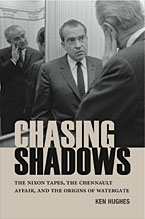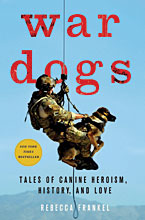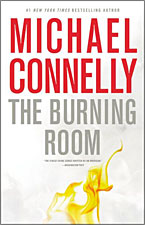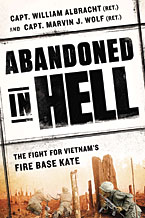 |
||||||||||||
|
Books in Review, January/February 2015 The Nixon Administration’s REVIEWS BY MARC LEEPSON
Ken Hughes, a researcher at the Miller Center’s Presidential Recordings Program, has spent ten years scrutinizing clandestinely recorded White House tapes from the Johnson and Nixon administrations. What Hughes has found on those tapes is the basis for his groundbreaking new book, Chasing Shadows: The Nixon Tapes, the Chennault Affair, and the Origins of Watergate (University of Virginia Press, 240 pp., $24.95). After leaving the presidency in disgrace in 1974, Nixon waged a legal battle to keep the public from learning what was on thousands of hours of unreleased White House tapes, Hughes writes. Aside from the tapes revealing stark evidence of his racism and anti-Semitism, Nixon fought to keep them secret for another reason: He knew they contained smoking-gun evidence of the crimes he had perpetrated before and after he took office. The first crime had a direct impact on the Vietnam War. It happened in the months before Nixon won the 1968 presidential election. Nixon—in cahoots with Anna Chan Chennault, a moving force behind the vehemently anti-communist China Lobby—secretly and successfully undermined the Paris peace talks. How? By having Chennault—working with Bui Diem, South Vietnam’s Ambassador to the U.S.—convince South Vietnam President Nguyen Van Thieu that he could get a better deal from the North Vietnamese under a Nixon presidency than he would in the last months of the Johnson regime, or in an administration led by Democratic nominee Hubert Humphrey. Thieu bought that argument and refused to cooperate with the North Vietnamese as negotiations were held to try to start peace talks. The upshot: the talks were delayed for many months and the war dragged on. In other words, Richard M. Nixon—aided and abetted by his foreign policy adviser, Henry Kissinger—knowingly prolonged the Vietnam War for his own political gain. As Hughes puts it, the South Vietnamese government, “in whose defense more than thirty thousand Americans had died and more than half a million Americans were currently risking their lives, had boycotted the Paris peace talks for the purpose of swinging the American presidential election to its preferred candidate, Richard Nixon.” Nixon played politics, Hughes notes, “with life-or-death matters of war and peace. His own secretly recorded White House tapes [and the Johnson White House tapes] would demonstrate” it. Johnson found out what Nixon was up to in late October of 1968, just as he was about to order a bombing halt and announce the start of peace talks. Johnson, as Hughes puts it, “received a warning that the Republican presidential nominee was trying to sabotage the peace talks before they even began.” What’s more, Nixon “in speech after speech” lied to the press and to Johnson, denying that he was monkeying with the peace process. In July of 1968, for example, he told a reporter he would not do anything “to jeopardize the chances for a [peace] settlement.” Hughes calls the Nixon sabotaging of the Paris peace talks “a scandal that cast doubt on the legitimacy of his entire presidency.” Then there was the second Vietnam-War-related crime exposed on the Nixon White House tapes: Nixon’s 1971 order to White House Chief of Staff Bob Haldeman to organize a break-in at the Brookings Institution, a liberal-leaning Washington think tank. Nixon ordered the burglary because he believed that Brookings had in its files a report detailing his 1968 illegal machinations to sabotage the Vietnam War peace talks. “Break into the place, rifle the files, and bring them in,” Nixon told Haldeman. Even though that burglary did not take place, the Nixon order constituted a federal crime. That order also led to the creation of a White House-funded “Special Investigations Unit” to do the illegal deed, a group that became known as the “Plumbers.” The Plumbers became infamous for another burglary that did take place: the July 1972 break-in at the Democratic National Headquarters at the Watergate. But that’s another story.
Most of the book deals with today’s military, but Frankel includes the war in Vietnam where dogs did valuable work in many areas—most significantly in helping detect “booby traps, land mines, trip wires, and the enemy’s intricate tunnel system,” as she notes. “From the beginning of their use in Vietnam, these canine teams gave patrols negotiating the froth and fray of the jungle an advantage against the guerrilla tactics used by Vietcong,” she writes. “Within a year of scout dogs’ arrival in Vietnam, they are reported to have saved over 2,000 lives.” Frankel devotes part of one chapter to telling the story of Ron Aiello, who served as a scout dog handler in the Vietnam War. Former Marine Aiello “still beams with pride for Stormy, the dog who accompanied him to Vietnam,” she writes. “From the way Aiello talks about her—immediate, vivid, and joyful—it’s as if Stormy is somehow at his feet or dozing in the next room, instead of a memory from a lifetime nearly half a century old.” Stormy performed effectively in Vietnam, but she stayed behind when Aiello rotated home in 1967. Aiello slept on the ground next to Stormy his last night in country to be with her “until the very last moment.” He spent years trying to find out what became of his beloved dog, but as was the case with “the majority of the some 10,000 handlers who served in Vietnam, Aiello never saw his dog again.” Frankel says that some 5,000 dogs served in Vietnam from 1964-75, and only 204 came home to the United States. Those left behind “were either euthanized or turned over to the South Vietnamese Army, which likely meant death.”
The story hums along with plenty of twists. The characters are well drawn and believable. The physical landscape of the greater Los Angeles area is sketched vividly and convincingly. The plot follows Connelly’s main Bosch formula: working with a new partner, Harry uses his brains and experience (and stretches legal limits a tad) to solve a perplexing crime. There are plenty of roadblocks, including the fact that the case is ten years old and that it leads to a related unsolved crime. Harry also runs into trouble from self-serving bureaucrats and from his teenage daughter. Bosch’s service in the Vietnam War plays a very small part in the book. The first mention doesn’t come until about a third of the way in. As usual, Connelly, who was in middle school during the height of the Vietnam War, does very well in the accuracy and verisimilitude departments when dealing with the Vietnam War and Harry’s role in it.
|
||||||||||||
|
|
||||||||||||
|
|
||||||||||||
8719 Colesville Road, Suite 100, Silver Spring. MD 20910 | www.vva.org | contact us |
||||||||||||












